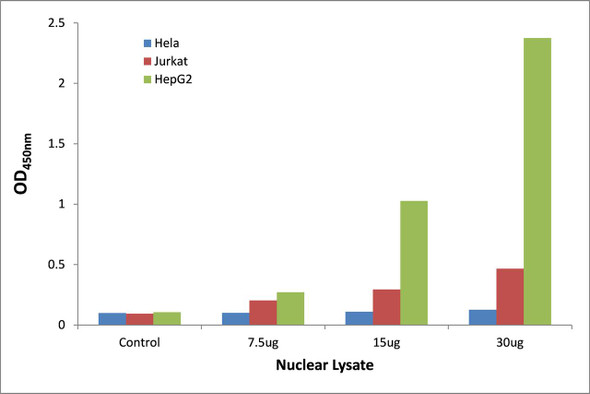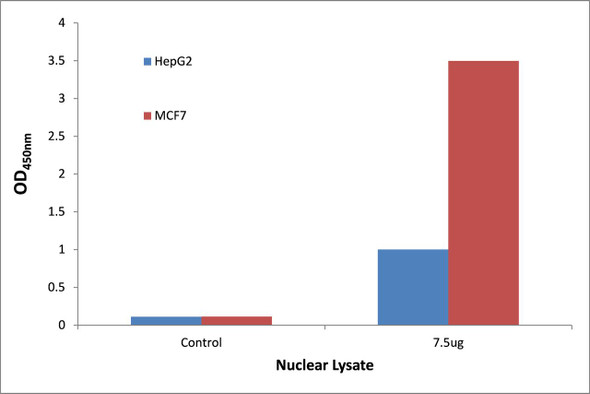Description
| Product Name: | AML1 Transcription Factor Activity Assay |
| Product Code: | TFAB00074 |
| Target: | AML1 |
| Synonyms: | Acute myeloid leukemia 1 protein, Core-binding factor subunit alpha-2, CBF-alpha-2, Oncogene AML-1, Polyomavirus enhancer-binding protein 2 alpha B subunit, PEA2-alpha B, PEBP2-alpha B, SL3-3 enhancer factor 1 alpha B subunit, SL3/AKV core-binding factor alpha B subunit |
| Reactivity: | Human, Mouse, Rat |
| Sample Types: | Nuclear or cell lysates |
The Assay Genie AML1 transcription factor activity assay allows for the detection and qualitative analysis of endogenous levels of activated transcription factors in a variety of nuclear and cell lysates
Assay Genie ELISA kits are designed to significantly reduce experiment time and ensure sensitivity and flexibility for high-throughput screening.
| Assay Time: | 4.5 hours |
| Detection Method: | Colorimetric 450 nm |
| Size: | 12 x 8-Well Microstrips |
| Storage: | 4°C for 6 months |
| UniProt Protein Function: | AML1: CBF binds to the core site, 5'-PYGPYGGT-3', of a number of enhancers and promoters, including murine leukemia virus, polyomavirus enhancer, T-cell receptor enhancers, LCK, IL-3 and GM-CSF promoters. The alpha subunit binds DNA and appears to have a role in the development of normal hematopoiesis. Isoform AML-1L interferes with the transactivation activity of RUNX1. Acts synergistically with ELF4 to transactivate the IL-3 promoter and with ELF2 to transactivate the mouse BLK promoter. Inhibits KAT6B- dependent transcriptional activation. Heterodimer with CBFB. RUNX1 binds DNA as a monomer and through the Runt domain. DNA-binding is increased by heterodimerization. Isoform AML-1L can neither bind DNA nor heterodimerize. Interacts with TLE1 and ALYREF/THOC4. Interacts with ELF1, ELF2 and SPI1. Interacts via its Runt domain with the ELF4 N-terminal region. Interaction with ELF2 isoform 2 (NERF-1a) may act to repress RUNX1-mediated transactivation. Interacts with KAT6A and KAT6B. Interacts with SUV39H1, leading to abrogation of transactivating and DNA-binding properties of RUNX1. Interacts with YAP1. Interacts with HIPK2. Interaction with CDK6 prevents myeloid differentiation, reducing its transcription transactivation activity. Expressed in all tissues examined except brain and heart. Highest levels in thymus, bone marrow and peripheral blood. 11 isoforms of the human protein are produced by alternative splicing. |
| UniProt Protein Details: | Protein type:Oncoprotein; Transcription factor; DNA-binding Chromosomal Location of Human Ortholog: 21q22.3 Cellular Component: nucleoplasm; intracellular membrane-bound organelle; cytoplasm; basement membrane; nucleus Molecular Function:protein binding; protein homodimerization activity; DNA binding; protein heterodimerization activity; calcium ion binding; transcription factor binding; transcription factor activity; ATP binding Biological Process: hair follicle morphogenesis; central nervous system development; transcription, DNA-dependent; embryonic hemopoiesis; in utero embryonic development; positive regulation of transcription, DNA-dependent; positive regulation of granulocyte differentiation; regulation of signal transduction; liver development; negative regulation of granulocyte differentiation; peripheral nervous system neuron development; behavioral response to pain; positive regulation of angiogenesis; myeloid progenitor cell differentiation; positive regulation of interleukin-2 production; myeloid cell differentiation; positive regulation of transcription from RNA polymerase II promoter; hemopoiesis; skeletal development Disease: Platelet Disorder, Familial, With Associated Myeloid Malignancy; Leukemia, Acute Myeloid; Rheumatoid Arthritis |
| NCBI Summary: | Core binding factor (CBF) is a heterodimeric transcription factor that binds to the core element of many enhancers and promoters. The protein encoded by this gene represents the alpha subunit of CBF and is thought to be involved in the development of normal hematopoiesis. Chromosomal translocations involving this gene are well-documented and have been associated with several types of leukemia. Three transcript variants encoding different isoforms have been found for this gene. [provided by RefSeq, Jul 2008] |
| UniProt Code: | Q01196 |
| NCBI GenInfo Identifier: | 215274205 |
| NCBI Gene ID: | 861 |
| NCBI Accession: | Q01196.3 |
| UniProt Secondary Accession: | Q01196,O60472, O60473, O76047, O76089, Q13081, Q13755 Q13756, Q13757, A8MV94, B2RMS4, D3DSG1, |
| UniProt Related Accession: | Q01196 |
| Molecular Weight: | 453 |
| NCBI Full Name: | Runt-related transcription factor 1 |
| NCBI Synonym Full Names: | runt-related transcription factor 1 |
| NCBI Official Symbol: | RUNX1 |
| NCBI Official Synonym Symbols: | AML1; CBFA2; EVI-1; AMLCR1; PEBP2aB; AML1-EVI-1 |
| NCBI Protein Information: | runt-related transcription factor 1; CBF-alpha-2; PEA2-alpha B; PEBP2-alpha B; oncogene AML-1; AML1-EVI-1 fusion protein; acute myeloid leukemia 1 protein; SL3-3 enhancer factor 1 alpha B subunit; SL3/AKV core-binding factor alpha B subunit; core-binding factor, runt domain, alpha subunit 2; polyomavirus enhancer-binding protein 2 alpha B subunit |
| UniProt Protein Name: | Runt-related transcription factor 1 |
| UniProt Synonym Protein Names: | Acute myeloid leukemia 1 protein; Core-binding factor subunit alpha-2; CBF-alpha-2; Oncogene AML-1; Polyomavirus enhancer-binding protein 2 alpha B subunit; PEA2-alpha B; PEBP2-alpha B; SL3-3 enhancer factor 1 alpha B subunit; SL3/AKV core-binding factor alpha B subunit |
| Protein Family: | Runt-related transcription factor |
| UniProt Gene Name: | RUNX1 |
| UniProt Entry Name: | RUNX1_HUMAN |






